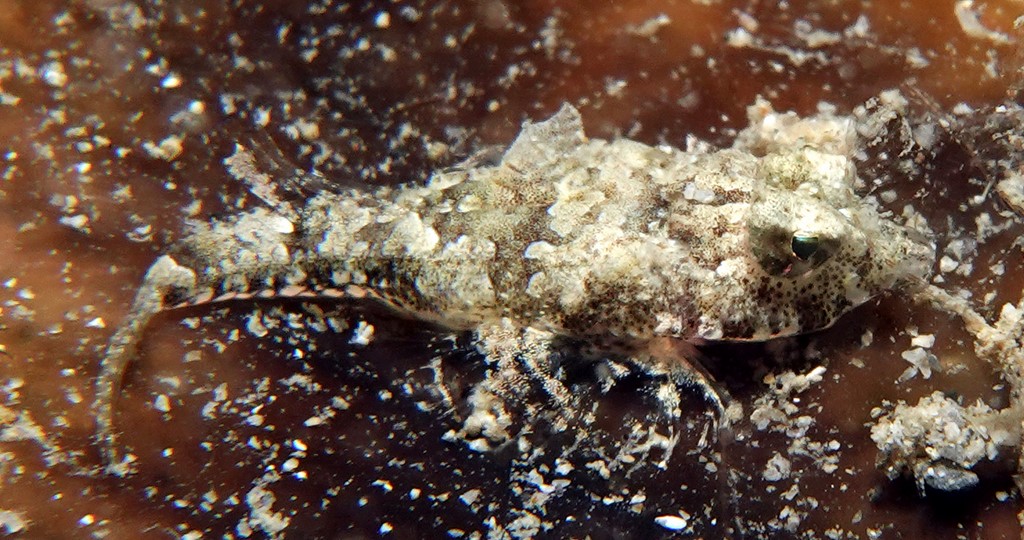CALLIONYMUS CORALLINUS - (GILBERT, 1905)
Picture courtesy of: Yves Thévenet
Actinopterygii (Gigaclass) > Actinopteri (Class) > Teleostei (Subclass) > Syngnathiformes (Order) > Callionymoidei (Suborder) > Callionymidae (Family) > Callionymus (Genus)Dragonnet corail, Coral Dragonet, Coralline dragonet, Exclamation point dragonet, Sango-hanabi-numeri, サンゴハナビヌメリ, 珊瑚擬雙線䲗,
Synonymes
Paradiplogrammus corallinus (Gilbert, 1905)
Synchiropus corallinus (Gilbert, 1905)
-------------------------
Description
Dorsal spines (total): 4; Dorsal soft rays (total): 9-10 (usually: 9); Anal soft rays: 8; Pectoral fin rays: 19-21; Pelvic fin rays: I, 5; Vertebrae: 7 + 14. Body elongate and slightly depressed, body depth: 4.5-7.2 in SL. Head slightly depressed: 3.0-3.6 in SL. Eye with a short supraorbital tentacle; Eye diameter: 2.3-3.0 in head. Preorbital length: 2.9-3.5 in head. Interorbital distance: 10-23 in head. Maxillary length: 2.9-3.3 in head. Preopercular spine length: 2.8-4.1 in head. Preopercular spine formula: 1 (4-5) 1. Body width: 5.3-6.1 in SL. Urogenital papilla length in males: 15-56 in head, 49 or more in head or not visible in females. Caudal peduncle length: 4.8-6.8 in SL. Caudal peduncle depth: 12.9-18.4 in SL. First dorsal fin high in the male, without filaments; First spine: 2.4-5.0 in SL, 2nd spine: 2.4-5.1 in SL, 3rd spine: 2.6-5.4 in SL, 4th spine: 2.9-6.7 in SL; In the female lower, 1st spine: 5.3-6.3 in SL, 2nd spine: 5.3-5.4 in SL, 3rd spine: 5.8-6.1 in SL, 4th spine: 6.1-9.7 in SL. Predorsal length: 2.6-3.7 in SL. Second dorsal fin rays unbranched, the last divided at its base; The 5th to 8th rays may be branched in large specimens. First ray of second dorsal fin in the male: 4.5-5.8 in SL, last ray: 5.0-7.4 in SL; First ray in the female: 5.3-7.3 in SL, last ray 6.7-8.8 in SL. Predorsal length: 1.8-2.2 in SL. Anal fin beginning on a vertical through 2nd membrane of second dorsal fin. Anal fin rays unbranched, the last divided at its base. First anal fin ray in the male: 8.9-13.2 in SL, last ray: 5.0-8.5 in SL; First ray in the female: 9.4-13.1 in SL, last ray: 6.0-7.9 in SL. Preanal fin length: 1.7-2.1 in SL. Pectoral fin reaching to 2nd or 3rd anal fin membrane when laid back. Pectoral fin length: 3.8-5.2 in SL. Prepectoral fin length: 2.4-2.7 in SL. Pelvic fin reaching to anus or first anal fin membrane when laid back. Pelvic fin spine: 8.5-17.4 in SL; Pelvic fin length: 3.0-4.0 in SL. Prepelvic fin length: 3.3-3.8 in SL. Caudal fin distally slightly convex; Caudal fin length: 3.4-4.1 in SL. Max. length: 3.7 cm SL (male); 4.0 cm SL (female). Depth range: 12 - 122 m, usually: 15 - 16 m.
Color
Color variable - Head and body dorsally brown, laterally red, ventrally white. Sides of head in the male with blue spots and lines. Body sides with numerous white blotches. Back dorsally with 3 dark brown saddles. First dorsal fin in males yellow, with vertical dark olive lines ocellate with blue; In females whitish, with yellow marblings, third and fourth membranes with dark olive. Second dorsal and caudal fins in males with horizontal dark olive lines surrounded with blue spots, fin distally yellow; In females dark olive, rays with blue spots. Anal fin in males basally whitish, the distal three fourths black, rays blue; In females translucent. Pectoral fin translucent, in males with basal orange spots. Pelvic fin whitish, basally and distally with dark olive spots, in the males basally also with small bluish white ocelli.
Etymology
Callionymus: from Greek, kallos = good, beautiful + from Greek suffix, -onym = name, word, with a better name. Callionymus (Linnaeus, 1758) is also the latinization of kallionymos, Aristotle’s name for stargazers (Uranoscopidae), which Linnaeus apparently confused with dragonets.
corallinus: from Latin, corallium = coral. Referring to “many minute round spots of coral-red, covering upper part of snout, interorbital space with upper part of eyeballs, upper half of opercles, and the preopercular spine”.
Original description: Callionymus corallinus Gilbert, 1905 - Type locality: Avau Channel, between Maui Island and Lanai Island, Hawaiian Islands, Albatross station 3873, depth 32-37 fathoms.
Distribution
Western Pacific, antiequatorial: southern Japan, Hawaiian Islands; Queensland (Australia) to Grande Terre (New Caledonia) and Ha'apai Group (Tonga).
Biology
Found on mixed volcanic and coral sand, broken shells, and rubble substrate, with low relief and no algal cover (rarely on pure sand).
Similar species
Synchiropus kiyoae (Fricke & Zaiser, 1983) - Reported from Northwestern Pacific: southern Japan.
Found on mixed volcanic and coral sand, broken shells, and rubble substrate, with low relief and no algal cover (rarely on pure sand).
Similar species
Synchiropus kiyoae (Fricke & Zaiser, 1983) - Reported from Northwestern Pacific: southern Japan.
Last update: 21, May 2023
